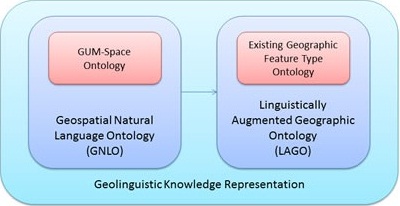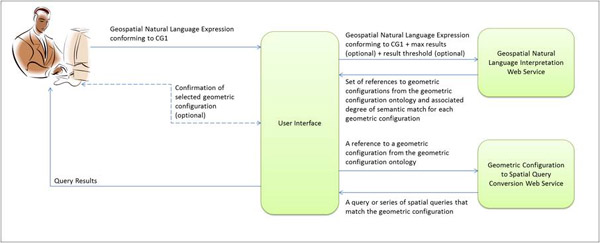Current research project: NaturalGeo
The NaturalGeo Project aims to develop methods for automated interpretation of geospatial natural language, with a particular focus on creating a mechanism for converting geospatial natural language expressions (for example, of the kind found in the NCGL), into queries that can be executed in a geographical information system (GIS) or a spatial data infrastructure (SDI).
The problem is to resolve issues of ambiguity that are inevitably part of natural language, and we are developing context sensitive approaches to try to interpret expressions and resolve ambiguity. The approach is implemented using ontologies.
The project focuses on the aspect of natural language geospatial querying that allows a user to request geographic information based on the location of the objects concerned. The objectives for the project are:
- To develop methods to map from geospatial natural language to a geospatial knowledge representation devised as part of the project.
- To develop methods to convert the knowledge representation into actual executable geospatial queries.
- To implement the approach and knowledge representation devised in the preliminary investigation and the mapping methods from 1 and 2.
- To demonstrate and test the approach with a simple web application returning results for natural language geospatial queries over geospatial data.
The knowledge representation for the project is shown next:

Figure 1: NaturalGeo knowledge representation

Figure 2: An architecture for natural language intepretation (NaturalGeo)
In addition to the interpretation method itself, our scientific contributions under this project (currently being developed) include a geometric configurations ontology, which describes spatial relations, but differs from them in that it is not an ontology of language terms used to describe spatial relations, but an ontology of geometric relations between objects, and can potentially be expanded to include aspects like shape - thus far we are focussing on the geometric configurations that are commonly found in natural language, often with several natural language expressions mapping to one geometric configuration.
We are also working on qualitative spatial reasoning treatments of:
- Collocation
- Sidedness
- Object parthood - side, end, front, and so on
- Adjacency and alignment
Project runs: 2012-14
Project contact: Kristin Stock